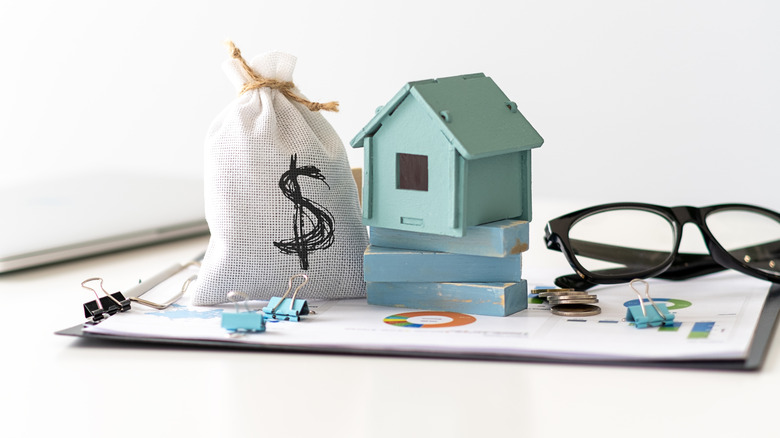If Your Monthly Home Costs Are Above This Number, It's Time To Downsize
Everyone needs a place to live. However, housing costs are rising at an unprecedented rate. The contemporary housing market is particularly unfriendly to almost everyone involved. Those looking to buy and/or sell a home face significant challenges, while renters face their own levels of uncertainty. Since September 2021 the ever-increasing CPI for average rental costs throughout U.S. cities has taken a huge turn northward. As of August 2025, the average rent across the United States stands at $1,638 per month (with an average apartment measuring just under 700 square feet, per Apartments.com), but this varies greatly by state and local area.
While renters are similarly stretched thin, they have expanded mobility that isn't generally part of the homeowner experience. Renters have the ability to pack up and move at the end of their lease (or even potentially midway through). This allows a renter to reevaluate their finances, and move, if things change in their life. This mobility can become incredibly handy if your housing costs rise above 30% of your gross income — a benchmark widely recognized by experts. The stressors that drive inflation, as well as many other financial burdens, can bring about budgetary changes, and fast. This is is why keeping the 30% threshold in mind can help you sound the alarm when and if downsizing might become your best option.
30% is a good rule of thumb to keep finances afloat
Spending over 30% of your income on direct housing expenses is a big indicator of financial strain because of what it often means for other areas of your budget. According to Experian, most Americans carry credit card debt from one month to the next, with the average repayment to creditors standing at $1,237 per month in June 2025. In line with this 30% figure, it's a good idea to allocate 20% of your budget to savings and/or debt repayment. If you're stretched too thin, there may be little left over for retirement or other savings — not to mention discretionary spending needs.
Whether you're a homeowner or renter, this ceiling can act as an important guide to keeping your finances under control. If paying the U.S. average rent of $1,638 per month at 30% of your income (without considering utilities and other costs), your monthly check would be about $5,460, or $65,500 annually. However, if you're also an average borrower this would yield a 22.7% debt repayment figure. In this way, it's easy to see how this financial pressures stacks up. While renters have the greatest flexibility in this regard, it's important that everyone keep track of where they stand in terms of housing costs, and seek out options, like downsizing, to release financial tension when necessary.
Consider other budget-saving options, too
If downsizing isn't an option in the immediate present, other, more creative strategies might be necessary to bridge the gap. As a homeowner, you should set up a meeting with your bank to discuss options. If you simply stop paying your mortgage bill you may end up at risk of losing your home to foreclosure. Renters are at risk of a similar loss of their place to live, but in practical terms the consequences are less severe. Some options to help reduce housing costs include turning down your thermostat, taking shorter showers, and using your appliances less frequently. You might also consider renting out a spare bedroom if possible. This can chop into your total housing expenses in a big way.
Beyond direct expenses, there is also often a lot of 'fat' that can be trimmed out of a typical budget. Per a 2025 study from Bango, the average American pays for 5.4 subscription services, and 25% of consumers spend more than $100 per month on these expenses (the average is $90, per CNET). Cutting one or more services can free up cash each month, while smarter grocery shopping habits can be another point of relief. Per the USDA, Americans throw out roughly 30% to 40% of the U.S. food supply every year (and the average family of four wastes $1,500 in food annually, or $125 per month according to Earth.org). Bringing a shopping list with you can help drive this figure down while you wait out a lease or sell your home.


